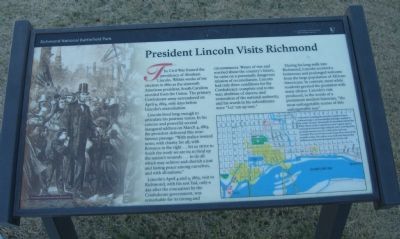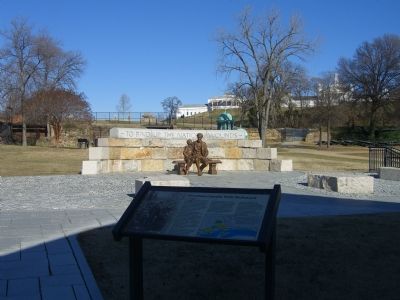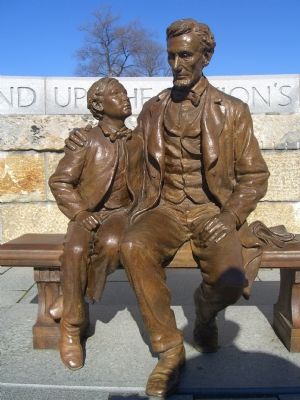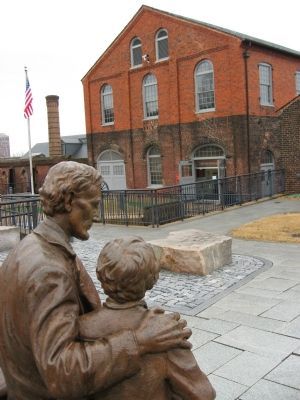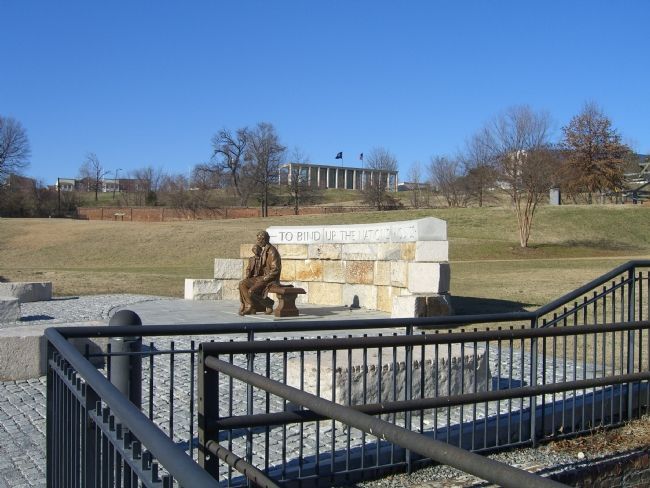Gambles Hill in Richmond, Virginia — The American South (Mid-Atlantic)
President Lincoln Visits Richmond
Lincoln lived long enough to articulate his postwar vision. In his concise and powerful second inaugural address on March 4, 1865, the president delivered this now-famous passage; “With malice toward none; with charity for all; with firmness in the right…let us strive to finish the work we are in; to bind up the nation’s wounds…to do all which may achieve and cherish a just and lasting peace among ourselves, and with all nations.”
Lincoln’s April 4 and 5, 1865, visit to Richmond, with his son Tad, only a day after the evacuation by the Confederate government, was remarkable for its timing and circumstances. Weary of war and worried about the country’s future, he came on a potentially dangerous mission of reconciliation. Lincoln had only three conditions for the Confederacy: complete end to the war; abolition of slavery; and his words to his subordinates were “Let ‘em up easy.”
During his long walk into Richmond, Lincoln received a boisterous and prolonged welcome from the large population of African-Americans. In contrast, most white residents greeted the president with stony silence. Lincoln’s visit produced, in the words of a prominent modern historian, “the most unforgettable scenes of this unforgettable war.”
Erected by Richmond National Battlefield Park, National Park Service, Department of the Interior.
Topics and series. This historical marker is listed in this topic list: War, US Civil. In addition, it is included in the Former U.S. Presidents: #16 Abraham Lincoln series list. A significant historical month for this entry is March 1865.
Location. Marker has been reported missing. It was located near 37° 32.138′ N, 77° 26.773′ W. Marker was in Richmond, Virginia. It was in Gambles Hill. Marker could be reached from Tredegar Street. Touch for map. Marker was at or near this postal address: 470 Tredegar Street, Richmond VA 23219, United States of America. Touch for directions.
Other nearby markers. At least 8 other markers are within walking distance of this location. A different marker also named President Lincoln Visits Richmond (a few steps from this marker); Tredegar in 1951 (a few steps from this marker); Belle Isle and Old Dominion Iron and Nail Works (within shouting distance of this marker); Raceways (within shouting distance of this marker); The Bulldozer Press (within shouting distance of this marker); Francis Turbine (within shouting distance of this marker); Adapting Power (within shouting distance of this marker); Early Industrial Patterns (within shouting distance of this marker). Touch for a list and map of all markers in Richmond.
More about this marker. On the left of this marker is an artist's rendering of, "President Lincoln entering Richmond."
On the lower right is a map of Richmond in 1865, during the time of Lincoln's visit. Its caption reads, "At Rocketts’ Landing the president stepped ashore without fanfare and unmindful of danger walked to the center of town. Eventually the president visited the White House of the Confederacy and Capital Square and took several carriage rides for more touring of the partially burned-out city. Little of his visit was recorded. The red arrows on the map show some of his possible routes. The yellow area indicates the portion of Richmond that burned just prior to his visit."
Adjacent to this marker is the sculpture titled, "President Abraham Lincoln and His Son Tad." On the bench to Lincoln's left is a newspaper, The Richmond Whig, dated April 5, 1865. Behind the statue is a stone wall, with the words "To bind up the nation's wounds," taken from Lincoln's second inaugural speech. The sculpture was commissioned by the U.S. Historical Society, who donated it to the National Park Service. The sculpture was created by David Frech and is set in front of a granite wall designed by architect Douglas Harnsberger. The sculpture commemorates Lincoln's only visit to the city in April 1865. The sculpture's subject and placement in a park that was the former site of Tredegar Ironworks, where Confederate materials were forged during the Civil War, was controversial.
Regarding President Lincoln Visits Richmond. Abraham Lincoln was a worn and weary fifty-six year old, and his son, Tad, an exhuberant and irrepressible boy, the day that father and son, hand in hand, made history in Richmond. It was April 4, 1865. It was Tad's 12th birthday.
It was also the day the President of the United States entered the city, which, until 36 hours earlier had served as the capital of the Confederacy-the epicenter of the war against the Union.
Now, the bloody struggle was drawing to a close. Confederate President Jefferson Davis had fled, and the mayor had surrendered the city to Union forces. As one horrified observer recalled, the ruins of Richmond were "still smoking...its devastation complete," set afire by fleeing Confederate soldiers.
Abraham Lincoln was determined to see the grim scene for himself. For more than a week he had been visiting federal military headquarters at nearby City Point, eager to be on hand for the end of the long and bloody Civil War. But not as a conquerer. "They do not know Lincoln," predicted journalist Noah Brooks, "who suppose that he will make a parade of himself at Richmond...or given the character of personal triumph to his entry in the rebel Capital."
And so, on Tuesday morning, April 4, at around 9 a.m., the sixteenth President of the United States, along with Tad, disembarked at Richmond's Rocketts Landing to symbolically reunite his battle-torn
country.
"It was the man of the people among the people," marveled an eyewitness. "It was the great deliverer meeting the delivered...such wild indescribable joy I never witnessed. The majority of the thousands who crowded the streets and hindered our advance were slaves. Now they were free, beholding him who had given them their liberty."
But the president himself would not live long enough to lead the new birth of freedom. Just a few days later, he was assasinated. As Tad bravely told a friend: "Pa is dead, and I am only Tad Lincoln now, little Tad, like other boys. I am not a President's son now."
Description courtesy United States Historical Society brochure from statue unveiling and dedication ceremony.
Credits. This page was last revised on March 19, 2023. It was originally submitted on January 18, 2008, by Kevin W. of Stafford, Virginia. This page has been viewed 5,936 times since then and 64 times this year. Photos: 1, 2, 3, 4, 5. submitted on January 18, 2008, by Kevin W. of Stafford, Virginia.
